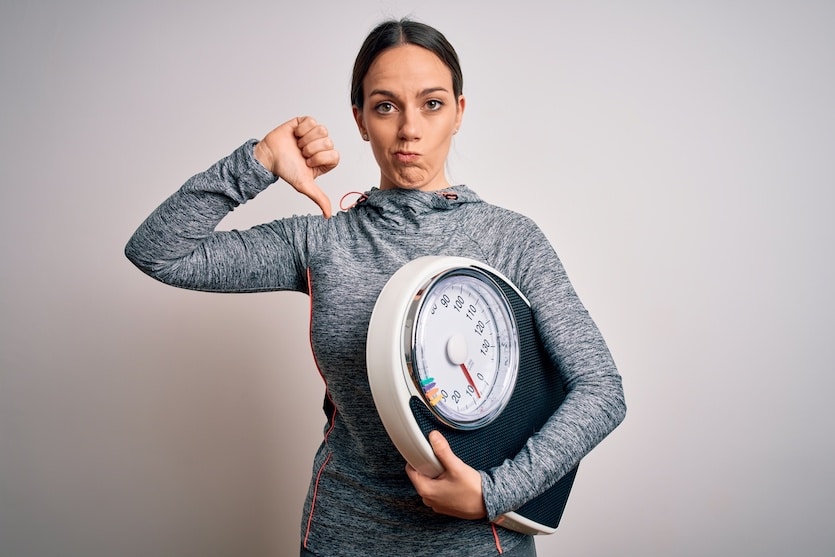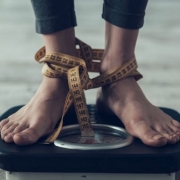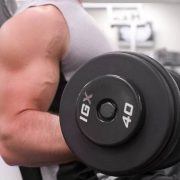Skip the scale: Rethink Fitness on Your Own Terms

In recent years, society has made a noticeable shift towards greater body positivity and body acceptance. People are encouraged to evaluate their health and wellness not based on weight or appearance, but rather on how they feel. After all, everybody—and every body—is different. And so, naturally, wellness looks a little different for everyone.
The same is true of fitness. And yet the rhetoric and practices surrounding personal fitness haven’t really caught on to this fact. Most people think of fitness in limited terms. A “fit” person, according to most, is someone who goes to the gym, someone who counts calories, someone who jogs five times a week. This version of fitness works for some people, but for others it can be discouraging. But here’s the truth: fitness looks a little bit different for everyone.
So if you’ve found yourself getting discouraged when it comes to reaching your fitness goals, it might be time to take a step back and redefine what fitness means to you.
Rethinking Fitness: Finding Your “Why”
If you’ve ever wanted to “get in shape” or improve your fitness, welcome to the club. It’s one of the most common goals people have for themselves. And one of the most poorly defined.
Far too many people think of fitness solely in terms of weight. “Getting in shape” means shedding a few pounds. Society seems to have this preconceived notion of what “fit” people look like and how much they weigh. But this is just one way of approaching and measuring your own fitness. The benefits of exercise are far-reaching, to say the least. And so there are dozens of ways to define fitness for yourself—and just as many ways to measure your progress towards that goal. So how do you choose which elements of health and wellness to focus on? That depends on your “why.”
Before setting fitness goals for yourself, you’ll need to have a clear understanding of why you want to improve your own fitness. Are you hoping to improve your stamina as you run errands and face the physical demands of day-to-day life? Are you training for a sporting event or season? Are you trying to shed a few pounds? Or are you hoping to just feel better? Your motivation could be anything, really, but only you can identify it.
Once you’ve identified why you want to improve your fitness, you can begin defining what that journey will look like for you. But more on that in the next section!
Defining Fitness for Yourself
A hardcore cyclist probably isn’t going to measure their fitness with timed swimming splits. And a long-distance runner probably won’t meticulously track how much they can bench press. You get the point: the guideposts on your fitness journey need to match your goal.
Here’s an example. If your goal is to improve your mental health—an often overlooked benefit of exercise—fitness might mean taking daily walks. As you pursue that fitness goal, you might keep a daily journal monitoring your mood, thoughts, and emotions. You’re probably not going to be focused on the distance of each walk, or your heart rate each time you go out. That information doesn’t help you measure your progress towards your own personal fitness—which, for you, is mental wellbeing from day-to-day.
Whatever version of fitness you choose to pursue, try to take a holistic approach. It’s good to set goals and measure your progress, but don’t let that get in the way of your feelings. At the end of the day, what good is fitness if you feel lousy? If you find that you are making yourself miserable in pursuit of fitness, that’s a good indicator that you need to take a step back and reevaluate: is the version of fitness you are chasing right for you? Or do you need to redefine fitness again?
3 Ways to Measure Physical Fitness Without a Scale
When it comes to redefining personal fitness, people often struggle to get away from the scale. It’s an understandable challenge. Weight gives you a single number that you can track over time, making it incredibly easy to set weight-related goals. But there are countless other aspects of physical fitness, many of which will more accurately reflect your fitness growth. Here are three areas of physical fitness you can track instead of weight:
- Aerobic fitness: Your body’s cardiovascular system (i.e. heart and blood vessels) carries oxygen to your muscles to help them, well, do what muscles do best: move. The better your aerobic fitness, the more efficiently your body can transport oxygen. One of the easiest ways to measure aerobic fitness is by monitoring your resting heart rate. Just like weight, this will give you a single number that you can track over time. For most adults, doctors consider a resting heart rate anywhere between 60 and 100 beats per minute (BPM) as normal or healthy. If you regularly perform aerobic exercise (running, swimming, anything that gets your heart rate up), you will likely notice your resting heart rate go down over time. This is a sign that oxygen is being delivered more efficiently!
- Muscular strength: If your goal is to improve your strength, you’re in luck. That’s one of the easiest aspects of physical fitness to measure and track. There are simple exercises you can perform at home—such as push ups and sit ups—to measure your physical strength and endurance. Or, if you’re a gym goer, you’ll likely notice your strength increasing in the exercises you perform there. This could mean getting an extra rep or two in, or being able to lift more weight in general.
- Flexibility: Though it’s often overlooked, flexibility plays a huge role in physical fitness. Your body’s ability to stretch and move without injury is vital for most forms of exercise. And what’s more, increased flexibility can increase your comfort performing daily tasks, whether it’s picking up a toddler or simply making your bed. There are hundreds of ways to measure your flexibility, but one of the most straightforward is the sit-and-reach. Simply sit on the floor with your legs straight in front of you and lean forward. As you stretch your arms towards your toes, take note of how far down your shin—or past your toes—you can reach.
Fitness and Frustration: Being Patient With Yourself
No matter how you define fitness for yourself, there will be ups and downs on your fitness journey. Some weeks you may stick to your routines better than others. There will almost certainly be times you come short of your goals. And there is nothing wrong with that.
Take these moments as learning opportunities, forgive yourself, and move on. That’s the great thing about fitness: it’s a process. And there’s always tomorrow to start again.
References
https://my.clevelandclinic.org/health/articles/7050-aerobic-exercise
https://www.mayoclinic.org/healthy-lifestyle/fitness/in-depth/fitness/art-20046433
https://www.self.com/story/how-to-set-realistic-fitness-goals
https://www.health.com/fitness/fitness-goals
https://www.theguardian.com/lifeandstyle/2020/jan/02/how-to-set-fitness-goals-you-will-actually-keep












